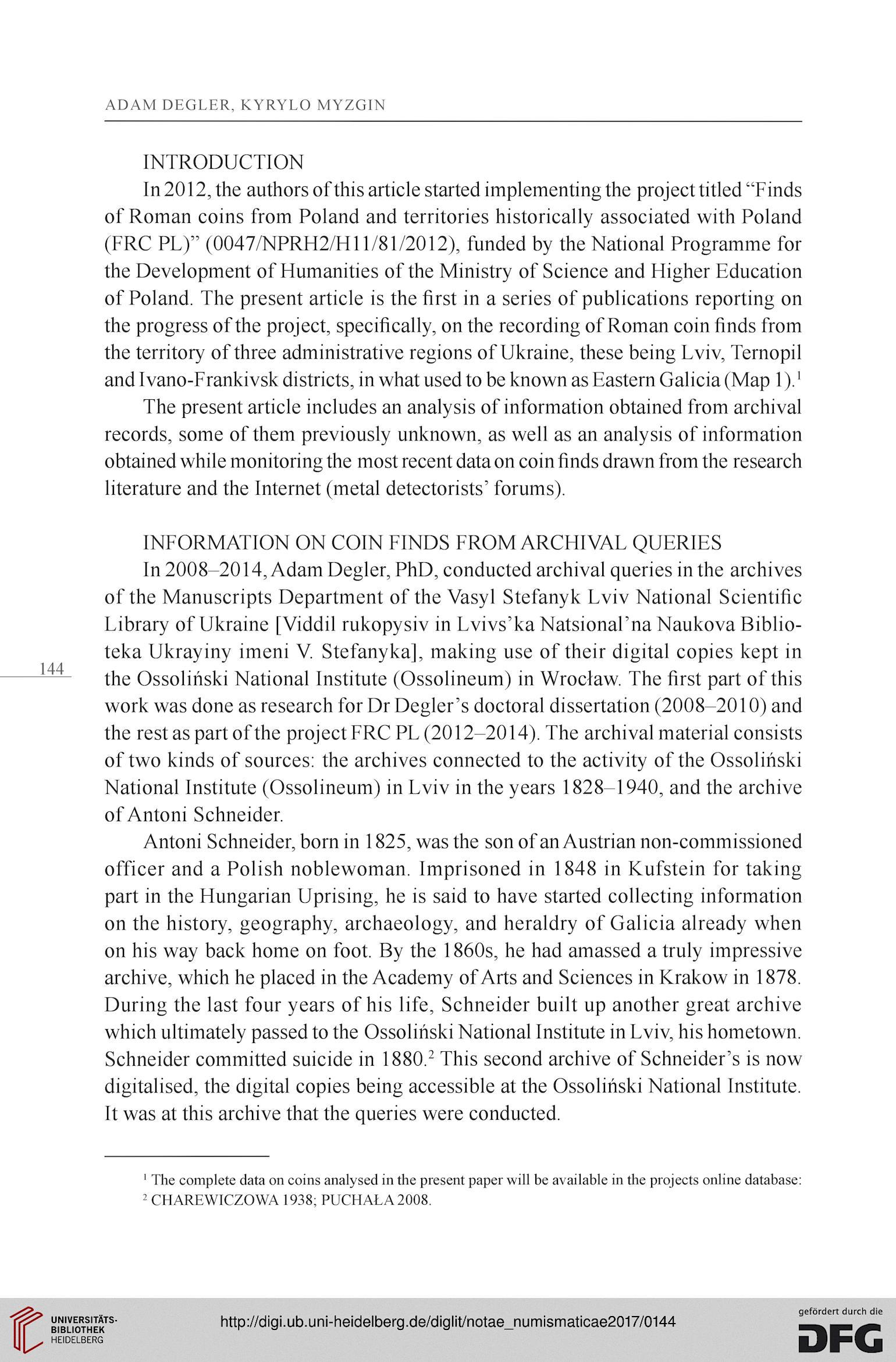ADAM DEGLER, KYRYLO MYZGIN
INTRODUCTION
In2012, the authors ofthis article started implementing the project titled “Finds
of Roman coins from Poland and territories historically associated with Poland
(FRC PL)” (0047/NPRH2/H11/81/2012), funded by the National Programme for
the Development of Humanities of the Ministry of Science and Higher Education
of Poland. The present article is the first in a series of publications reporting on
the progress of the project, specifically, on the recording of Roman coin finds from
the territory of three administrative regions of Ukraine, these being Lviv, Ternopil
and Ivano-F ranki vsk districts, in what used to be known as Eastern Galicia (Map 1).1
The present article includes an analysis of information obtained from archival
records, some of them previously unknown, as well as an analysis of information
obtained while monitoring the most recent data on coin finds drawn from the research
literaturę and the Internet (metal detectorists’ forums).
INFORMATION ON COIN FINDS FROM ARCHIVAL QUERIES
In 2008-2014, Adam Degler, PhD, conducted archival queries in the archives
of the Manuscripts Department of the Vasyl Stefanyk Lviv National Scientific
Library of Ukraine [Viddil rukopysiv in Lvivs’ka NatsionaFna Naukova Biblio-
teka Ukrayiny imeni V. Stefanyka], making use of their digital copies kept in
the Ossoliński National Institute (Ossolineum) in Wroclaw. The first part of this
work was done as research for Dr Degler’s doctoral dissertation (2008 2010) and
the rest as part of the project FRC PL (2012-2014). The archival material consists
of two kinds of sources: the archives connected to the activity of the Ossoliński
National Institute (Ossolineum) in Lviv in the years 1828-1940, and the archive
of Antoni Schneider.
Antoni Schneider, born in 1825, was the son of an Austrian non-commissioned
officer and a Polish noblewoman. Imprisoned in 1848 in Kufstein for taking
part in the Hungarian Uprising, he is said to have started collecting information
on the history, geography, archaeology, and heraldry of Galicia already when
on his way back home on foot. By the 1860s, he had amassed a truly impressive
archive, which he placed in the Academy of Arts and Sciences in Krakow in 1878.
Düring the last four years of his life, Schneider built up another great archive
which ultimately passed to the Ossoliński National Institute in Lviv, his hometown.
Schneider committed suicide in 1880.2 This second archive of Schneidens is now
digitalised, the digital copies being accessible at the Ossoliński National Institute.
It was at this archive that the queries were conducted.
1 The complete data on coins analysed in the present paper will be available in the projects online database:
2 CHAREWICZOWA 1938; PUCHAŁA 2008.
INTRODUCTION
In2012, the authors ofthis article started implementing the project titled “Finds
of Roman coins from Poland and territories historically associated with Poland
(FRC PL)” (0047/NPRH2/H11/81/2012), funded by the National Programme for
the Development of Humanities of the Ministry of Science and Higher Education
of Poland. The present article is the first in a series of publications reporting on
the progress of the project, specifically, on the recording of Roman coin finds from
the territory of three administrative regions of Ukraine, these being Lviv, Ternopil
and Ivano-F ranki vsk districts, in what used to be known as Eastern Galicia (Map 1).1
The present article includes an analysis of information obtained from archival
records, some of them previously unknown, as well as an analysis of information
obtained while monitoring the most recent data on coin finds drawn from the research
literaturę and the Internet (metal detectorists’ forums).
INFORMATION ON COIN FINDS FROM ARCHIVAL QUERIES
In 2008-2014, Adam Degler, PhD, conducted archival queries in the archives
of the Manuscripts Department of the Vasyl Stefanyk Lviv National Scientific
Library of Ukraine [Viddil rukopysiv in Lvivs’ka NatsionaFna Naukova Biblio-
teka Ukrayiny imeni V. Stefanyka], making use of their digital copies kept in
the Ossoliński National Institute (Ossolineum) in Wroclaw. The first part of this
work was done as research for Dr Degler’s doctoral dissertation (2008 2010) and
the rest as part of the project FRC PL (2012-2014). The archival material consists
of two kinds of sources: the archives connected to the activity of the Ossoliński
National Institute (Ossolineum) in Lviv in the years 1828-1940, and the archive
of Antoni Schneider.
Antoni Schneider, born in 1825, was the son of an Austrian non-commissioned
officer and a Polish noblewoman. Imprisoned in 1848 in Kufstein for taking
part in the Hungarian Uprising, he is said to have started collecting information
on the history, geography, archaeology, and heraldry of Galicia already when
on his way back home on foot. By the 1860s, he had amassed a truly impressive
archive, which he placed in the Academy of Arts and Sciences in Krakow in 1878.
Düring the last four years of his life, Schneider built up another great archive
which ultimately passed to the Ossoliński National Institute in Lviv, his hometown.
Schneider committed suicide in 1880.2 This second archive of Schneidens is now
digitalised, the digital copies being accessible at the Ossoliński National Institute.
It was at this archive that the queries were conducted.
1 The complete data on coins analysed in the present paper will be available in the projects online database:
2 CHAREWICZOWA 1938; PUCHAŁA 2008.




